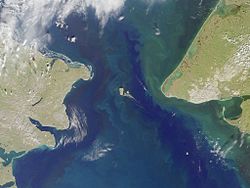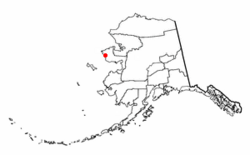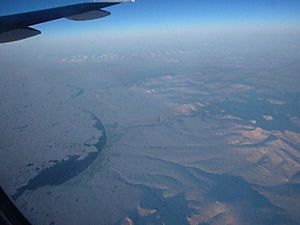Port Clarence, Alaska facts for kids
Quick facts for kids
Port Clarence, Alaska
|
|
|---|---|

Bering Strait. Port Clarence bay is the large bight in the southeast.
|
|

Location of Port Clarence, Alaska
|
|
| Country | United States |
| State | Alaska |
| Census Area | Nome |
| Area | |
| • Total | 35.02 sq mi (90.71 km2) |
| • Land | 34.05 sq mi (88.20 km2) |
| • Water | 0.97 sq mi (2.51 km2) |
| Elevation | 16 ft (5 m) |
| Population
(2020)
|
|
| • Total | 0 |
| • Density | 0.00/sq mi (0.00/km2) |
| Time zone | UTC-9 (Alaska (AKST)) |
| • Summer (DST) | UTC-8 (AKDT) |
| ZIP code |
99762
|
| Area code(s) | 907 |
| FIPS code | 02-63170 |
| GNIS feature ID | 1408213 |
Port Clarence is a small area in Alaska that was once counted as a "census-designated place" (CDP). A CDP is a place that looks like a town but isn't officially governed as one. It's located in the Nome Census Area.
In 2020, the population of Port Clarence was 0. This means no one lived there at that time. Back in 2010, 24 people lived there. Port Clarence is found on a narrow strip of land that separates Port Clarence Bay from the big Bering Strait.
Contents
History of Port Clarence
Early Events and Reindeer Rescue
A missionary named Sheldon Jackson had a very successful reindeer station at Port Clarence. This station played a big part in the Overland Relief Expedition in 1897. During this expedition, reindeer were used to help rescue whalers who were stuck near Point Barrow.
Gold Rush and Mining
Around 1898 and 1899, there was a big gold rush in Nome. During this time, people also found smaller amounts of gold in Port Clarence. They also mined for a valuable metal called tin there.
Exploring the Coastline
In 1899, a group called the Harriman Alaska Expedition visited Port Clarence. They took many photos of the Alaska Natives who lived there. The next year, in 1900, the United States Coast and Geodetic Survey created detailed maps of the coastline around Port Clarence.
The Tallest Structure in Alaska
From 1961 to 2010, Port Clarence was home to a special station called a LORAN-C station. The United States Coast Guard managed this station. LORAN-C was a system that helped ships and planes figure out their exact location.
In 1961, the Coast Guard built a very tall LORAN-C tower at the station. It was 1,350 feet (411.48 meters) high! This made it the tallest structure in all of Alaska for many years. The LORAN-C program ended on February 8, 2010, and the tall tower was taken down that same year.
Geography of Port Clarence
Port Clarence is located at these coordinates: 65°15′58″N 166°51′10″W / 65.26611°N 166.85278°W.
The total area of Port Clarence is about 36.5 square miles (94.5 square kilometers). Most of this area, about 35.5 square miles (91.9 square kilometers), is land. The rest, about 1.0 square mile (2.6 square kilometers), is water.
Population Changes Over Time
| Historical population | |||
|---|---|---|---|
| Census | Pop. | %± | |
| 1890 | 485 | — | |
| 1980 | 29 | — | |
| 1990 | 26 | −10.3% | |
| 2000 | 21 | −19.2% | |
| 2010 | 24 | 14.3% | |
| 2020 | 0 | −100.0% | |
| U.S. Decennial Census | |||
Port Clarence first appeared in the U.S. Census in 1890. At that time, 485 people lived there. This count included people from several small native villages nearby. It also included sailors from six different ships that were in the area.
After 1890, Port Clarence was not counted separately in the census again until 1980. In 1980, it was officially named a census-designated place (CDP). Since then, the population has been very small. In 2000, there were 21 people living there. Most of these residents were men. By 2020, the population had dropped to zero.
Climate of Port Clarence
Port Clarence has a subarctic climate. This means it has very cold, long winters and short, cool summers. It's almost like a tundra climate, which is known for its extremely cold temperatures and frozen ground.
| Climate data for Port Clarence, Alaska | |||||||||||||
|---|---|---|---|---|---|---|---|---|---|---|---|---|---|
| Month | Jan | Feb | Mar | Apr | May | Jun | Jul | Aug | Sep | Oct | Nov | Dec | Year |
| Record high °F (°C) | 42 (6) |
45 (7) |
35 (2) |
48 (9) |
64 (18) |
76 (24) |
81 (27) |
80 (27) |
72 (22) |
51 (11) |
43 (6) |
35 (2) |
81 (27) |
| Mean daily maximum °F (°C) | 9.4 (−12.6) |
4.7 (−15.2) |
7.2 (−13.8) |
20.7 (−6.3) |
36.1 (2.3) |
48.9 (9.4) |
56.5 (13.6) |
54.2 (12.3) |
46.6 (8.1) |
33.1 (0.6) |
20.3 (−6.5) |
10.7 (−11.8) |
29.0 (−1.7) |
| Daily mean °F (°C) | 2.8 (−16.2) |
−1.6 (−18.7) |
1.0 (−17.2) |
12.9 (−10.6) |
30.2 (−1.0) |
43.1 (6.2) |
50.9 (10.5) |
49.8 (9.9) |
41.8 (5.4) |
29.1 (−1.6) |
15.4 (−9.2) |
4.7 (−15.2) |
23.3 (−4.8) |
| Mean daily minimum °F (°C) | −3.8 (−19.9) |
−8.1 (−22.3) |
−5.5 (−20.8) |
5.1 (−14.9) |
24.4 (−4.2) |
37.2 (2.9) |
45.4 (7.4) |
44.8 (7.1) |
36.9 (2.7) |
24.9 (−3.9) |
10.5 (−11.9) |
−1.4 (−18.6) |
17.5 (−8.1) |
| Record low °F (°C) | −44 (−42) |
−48 (−44) |
−36 (−38) |
−28 (−33) |
−6 (−21) |
20 (−7) |
20 (−7) |
25 (−4) |
18 (−8) |
−5 (−21) |
−12 (−24) |
−30 (−34) |
−48 (−44) |
| Average precipitation inches (mm) | 1.11 (28) |
1.47 (37) |
0.15 (3.8) |
0.46 (12) |
0.27 (6.9) |
0.70 (18) |
0.98 (25) |
1.82 (46) |
1.48 (38) |
0.92 (23) |
0.64 (16) |
1.26 (32) |
11.26 (286) |
| Average snowfall inches (cm) | 4.4 (11) |
11.7 (30) |
3.0 (7.6) |
1.9 (4.8) |
0.4 (1.0) |
0.0 (0.0) |
0.0 (0.0) |
0.0 (0.0) |
0.0 (0.0) |
3.5 (8.9) |
5.2 (13) |
6.4 (16) |
36.5 (93) |
| Source: WRCC | |||||||||||||
See also
 In Spanish: Port Clarence (Alaska) para niños
In Spanish: Port Clarence (Alaska) para niños


